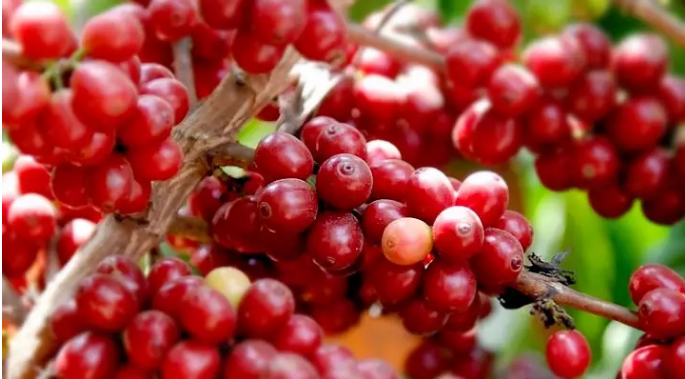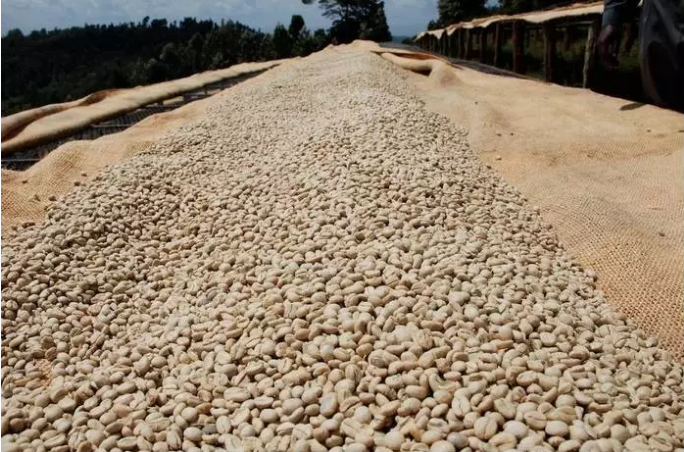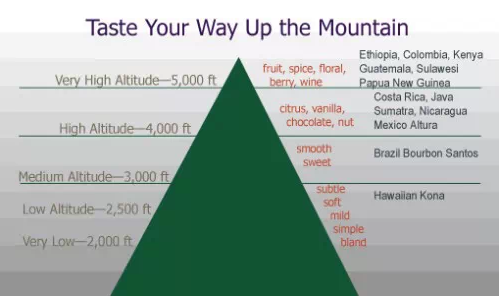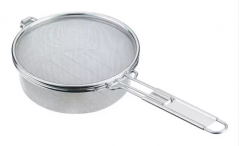Common sense of coffee beans: the relationship between the altitude of coffee growth and coffee flavor

We should all understand that raw coffee beans are generally classified according to raw bean size, defect rate and altitude. Many people do not quite understand why some producing areas should take the growth altitude of coffee beans as the basis for grading. Many coffee sellers also advertise their coffee as high-altitude coffee and sell it at a high price, which is also the most common problem encountered in grading to students.
Why grade coffee beans on the basis of elevation?
First of all, we should realize that the influence of geographical location on the flavor of coffee beans is profound. All coffee grows in the tropics. In fact, altitude has no direct effect on coffee. However, altitude can affect the growth, development and quality of coffee through the redistribution of meteorological elements (temperature, light, heat, wind speed, rainfall, etc.).
The tropical region between the Tropic of Cancer and Tropic of Cancer produces the world's truly high-quality Arabica coffee in Central and South America, South Asia and some Pacific islands, central and southern Africa is also the most important coffee growing area in the world. 3000-6000 feet (2000 meters) high altitude provides ideal conditions for coffee growth: an average frost-free climate of 60-70 degrees Fahrenheit (15-21) throughout the year and about 80 inches of moderate rainfall In addition, the coffee beans in the mountainous areas with abundant sunshine and low temperature grow slowly, and the slow ripening process makes the coffee beans have higher sugar content, more interesting flavor, higher displacement at higher altitude, and more concentrated fruit flavor. the best Arabica coffee growing areas have very fertile soil and tend to be in volcanic areas.

Coffee beans grown at high elevations are hard, dense, and have the potential to give play to a special flavor. the really amazing coffee growing areas are at high altitude. these beans are picked carefully only in the mature season, generally with the increase in altitude. The aroma of coffee will become more and more prominent and unique (see figure) from the temperature and sweetness of Brazilian beans at a low altitude of 3500 feet to a surge in the taste of Ethiopian coffee beans above 6000 feet. Altitude will give coffee beans a more complex and subtle taste.

The rating of Central American coffee is based on the altitude at which the coffee grows.
Mexico, Honduras, Haiti and other countries are rated at a high level.
Strictly High Grown (SHG), followed by High Grown (HG)
Mexico is called Altura, which means high in Spanish, which means high-altitude coffee; Papua New Guinea adds the name "Mile High" to mark coffee beans grown in the highlands and mountains.
Guatemala, Nicaragua, El Salvador, Costa Rica and other countries are classified as follows:
Grade growth height grade abbreviation
Strictly Hard Bean
(extremely hard beans) about 1372 to 1524m SHB
Good Hard Bean
(high hard bean) about 91401372m GHB
Hard Bean (hard bean) is about 610-914m HB
Pacific
(Pacific coastal area) about 300m to 1000m Pacific
Practice shows that the effect of altitude on quality has exceeded the effect of genotype on quality, and Viagra personally thinks that the classification of coffee beans based on altitude is more scientific and reasonable than that based on size and defect rate altitude. because to a certain extent, altitude classification is indirectly graded by taste, the beans with low altitude grow fast and large, and the defect rate can be changed by selection, but altitude can not be changed.
According to the measurement, compared with the same kind of coffee beans, the higher the altitude, the greater the acidity, the lower the concentration; on the contrary, the smaller the acidity, the higher the concentration, so high altitude coffee is very suitable for those who like sour taste and low concentration. It's your good coffee. For those who do not like the sour taste and require a high concentration of coffee, the higher the altitude, the less suitable the coffee is, no matter how high its quality is, it is also a waste product for yourself, so the choice of altitude should be determined according to the personal taste.

Secondly, how do we know if the coffee we buy is really high altitude? The calories on both sides of the Tropic of Cancer are relatively low, and most of them are less than 1000 meters in China, which are mainly distributed in Yunnan, so while making coffee well, we also need to understand the geography, climate and environment of the coffee producing area, do more and drink more in order to better understand the different flavor of coffee.
Important Notice :
前街咖啡 FrontStreet Coffee has moved to new addredd:
FrontStreet Coffee Address: 315,Donghua East Road,GuangZhou
Tel:020 38364473
- Prev

Practical information: can you play hand-net baking?
I have been learning coffee bean hand network roasting for more than two years, and I have roasted more than a hundred nets. During this period, I have consulted some professional roasters in China and Taiwan from time to time. I have received a lot of advice and correction from them, because I have always had respect for coffee roasting. So I didn't dare to post the first post about hand net baking until now. Do you ask yourself why you want to learn mobile web baking? As far as coffee lovers are concerned, hand net baking
- Next

Hand coffee filter cup is very knowledgeable! The devil is hiding in the velocity.
In the interview of the Japanese magazine, it is mentioned that the flow rate of several commonly seen coffee filter cups is a very interesting result, which usually does not seem to be discussed when making coffee by hand. So let's take a look at the picture above, from left to right, cooking time from fast to slow, in the following order: HARIO V60 KONO doughnut filter
Related
- Beginners will see the "Coffee pull flower" guide!
- What is the difference between ice blog purified milk and ordinary milk coffee?
- Why is the Philippines the largest producer of crops in Liberia?
- For coffee extraction, should the fine powder be retained?
- How does extracted espresso fill pressed powder? How much strength does it take to press the powder?
- How to make jasmine cold extract coffee? Is the jasmine + latte good?
- Will this little toy really make the coffee taste better? How does Lily Drip affect coffee extraction?
- Will the action of slapping the filter cup also affect coffee extraction?
- What's the difference between powder-to-water ratio and powder-to-liquid ratio?
- What is the Ethiopian local species? What does it have to do with Heirloom native species?

